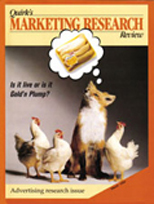Editor's note: Charlotte Rettinger is president of Charlotte Rettinger Inc., Great Neck, N.Y. Lee Slurzberg is president of Lee Slurzberg Research Inc., Fort Lee, N.J.
Focus groups have been conducted for advertising agencies for at least 40 years and the technique has settled into a "way of life." At this mature stage it is worth re-examining the state of the art to be sure that focus group projects are honed to respond to the needs of the 1990s. In particular, focus groups can be geared to develop and support brands and brand advertising worthy of consumer trust.
To that end, this article discusses:
- Why advertising agencies conduct focus groups;
- The types of focus groups they conduct;
- Appropriate techniques for each type of focus group;
- Designing focus groups.
Why advertising agencies use focus groups
Advertising agencies conduct focus groups to better understand consumer needs, wants, satisfaction, barriers and problems on a qualitative rather than statistical level. Information from these groups can be applied in many ways, such as:
- to clarify marketing issues;
- to identify salient consumer issues and their relative importance when creating initial advertising strategies;
- to develop a niche for differentiating a brand or product;
- to identify perceived product or service benefits and "reasons why," which help construct advertising strategy;
- to find a "hook" that will engage consumer interest;
- to obtain consumer reactions to alternative advertising executions;
- to develop hypotheses on what motivates consumers on a given issue; and
- to help write a questionnaire for a quantitative study.
Ad agencies generally use three types of focus groups for their research needs: motivational, see-hear-feel and developmental. Research objectives determine which type of focus group to use, with some overlap in what each type achieves.
Motivational focus groups
This type of focus group tries to uncover underlying motives influencing a particular behavior. Some typical research objectives might include writing a more persuasive ad claim, modeling the decision-making process within the family, or understanding the perceived primary benefit (for example, building shared family memories as the motivation for visiting a theme park).
Uncovering motivation is most useful to an advertising agency when creatives are looking for a new and compelling way to motivate the target audience. Ultimate goals might be a new business pitch, positioning new products or repositioning an existing brand.
See-hear-feel focus groups
Some marketers have never seen the faces or heard the voices of the consumers of their brands, products or services. These marketers could be newly appointed company presidents, junior copywriters or brand managers in a new assignment. No matter what their seniority, it's always worthwhile for the marketer to have a specific person in mind when making marketing and advertising decisions. The see-hear-feel type of group allows marketers to observe typical consumers and hear their language, reveals the tone-feeling of the group about the category and brands, elicits stated reasons why people use the category and explores feelings about brands (including direct comparisons).
Developmental focus groups
Experienced marketers often feel they know their consumers and understand consumer motivation. What they need and want is to develop a positioning, concept, advertising claim or prototype for their product or service. The developmental focus group is tailored for that process.
Developmental focus groups expose group members to some kind of stimulus and ask for in-depth reactions. The stimulus can be almost anything: commercials, print ads, concept statements, products, new TV shows, packaging alternatives, electronic equipment or hospital furniture.
Appropriate techniques for focus group types
These different groups call for different approaches and interviewing techniques within the open-ended context of qualitative research.
- The motivational type leans more heavily towards an unstructured approach, opening with the broadest salient discussion, then allowing participants to guide the discussion. Verbal and non-verbal projective techniques are often used, including role playing, drawing games, photo sorts, mental imaging and personification.
- The see-hear-feel type tends to a more structured approach; the questioning techniques, while still open-ended, are more apt to guide potential responses in a particular direction.
- The developmental type is usually the most structured of the three approaches, using a mix of alternative questioning techniques regarding the stimuli. These could include observations of reactions, direct questions and closed-end preferences as well as the more traditional open-ended questions and projective techniques.
Designing a focus group project
Besides the research objectives discussed above, market conditions also play a role when choosing the overall design of a research project that uses focus groups.
The questions below can help decide who to interview, in what cities, number of groups needed and the length and composition of the groups (Should we mix men and women? Income groups? Users of different brands? etc.)
- What other categories fill the same consumer need? What is their relative market size in dollars and consumers?
- Is the category and/or brand in development, new, growing, mature or declining?
- How many brands are there? What are they and what are their respective shares of volume and consumers?
- What are the relative brand spending levels? Are the brands national or regional?
- What is the definition of the primary user group? Who is the primary purchaser? Is the market heavily segmented? How?
Focus groups launched from this knowledge will reveal the nature of the opportunity for the brand and the challenges it will face in the marketplace. Findings from these groups will be on target, containing new ideas instead of confirming the familiar.
